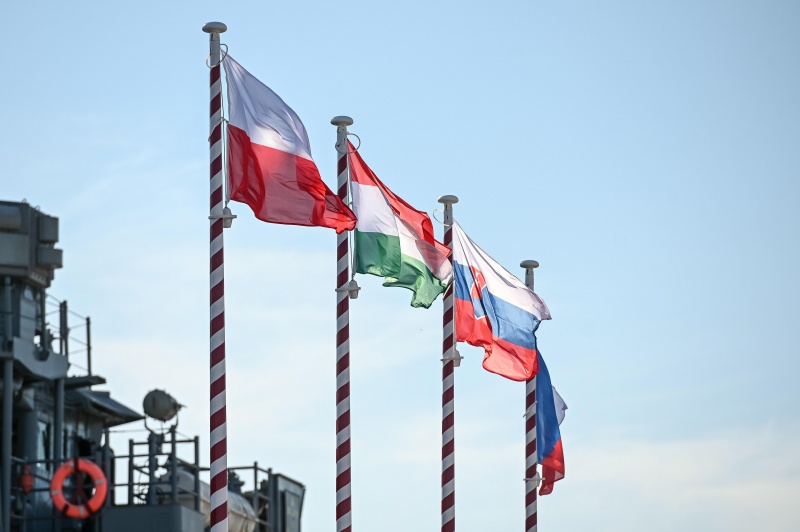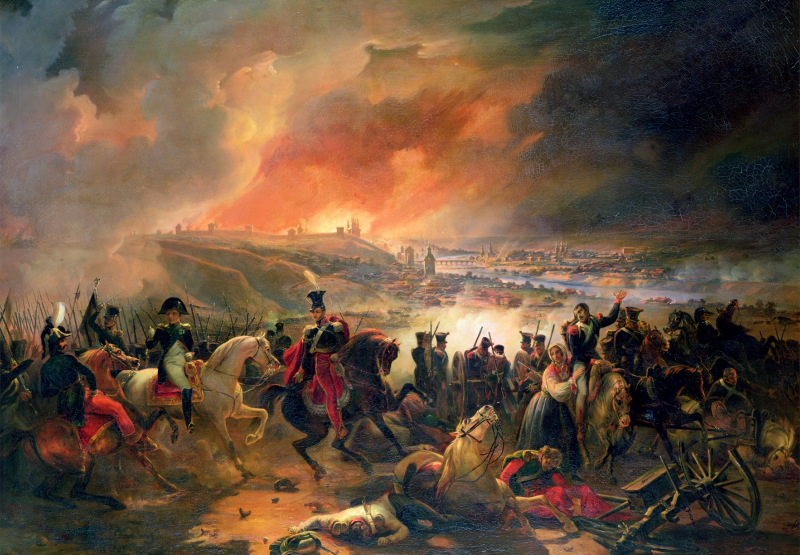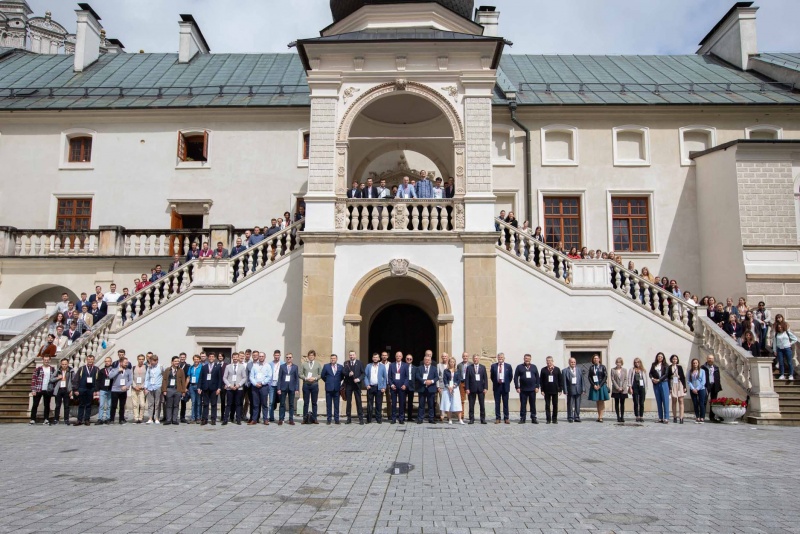Historical irony must be at play if the contemporary “Visegrád” foundation is a common historical experience stemming from more than 40 years of being part of, or to put it more bluntly, of subordination to and dependence on an eastern empire known as the Soviet Union – built by Lenin and consolidated by Stalin with the consent of the so-called western powers.
Dr Marek Natusiewicz

Visegrád Group national flags in the port of Gdynia, 20 June 2021. Photo by Jan Dzban / PAP
The Churchillian iron curtain severed the eastern part of the continent both from prosperous beneficiaries of the Marshall Plan and from any ideological innovations. More than 40 years is long enough to shape, over almost two generations, a completely new historical consciousness and cultural identity for the people living behind the “curtain”. For Poles, this was above all an interest not in the Second, but in the First Republic, as the official propaganda of the Polish People's Republic continually reviled the Second Republic, awakening, as is natural for the perversely fickle nature of Poles, sympathy for the times and people that made up the Second Polish Republic.
On the other hand, the “green light” for research into the evils of those times led thinking people to abstain from extreme condemnation and have a somewhat limited fascination with that period. This is probably why Paweł Jasienica's books were the most widely read historiosophical works in communist Poland. Studying the texts and conscious of the author's complex biography as well as the prevailing circumstances, one tended not to focus on the content conveyed, but rather made one’s perception more attune to the methodology for perceiving facts and analysing historical processes. And perhaps this is why communities that had different things to say about the reality of the time existed in the Polish People's Republic. And perhaps this is why they were handled differently by the dictatorial authorities – murders, long imprisonments, but also the licensing of political activity (ZNAK). These could be interpreted indirectly as a measure of the scale of the threat to the system.
Historical backdrop
The 19th century was a time of awakening for many European nations. For some of nothing more than the establishment of a state, as best demonstrated by Garibaldi's words (loosely translated): I have made a country, now it is time for a nation. Visegrád nations and countries "woke up" in an almost similar manner – at first a nation was recreated in the hope that the opportunity would come to reclaim its country. There were different starting points, different methods, objectives were formulated differently.
The Hungarians were in the best situation. After the failed 1848/1849 revolution, on the back of a favourable political situation (Austria’s defeat in the war against the Kingdom of Prussia) and through the kindness of the Empress Elisabeth, they regained their state within the Imperial and Royal Austro-Hungarian Empire in 1867. However, the Habsburgs, having wielded imperial power for centuries, knew the effectiveness of the divide et impera strategy. In Austrian practice, this amounted to: “selling” all Slavic (except Poles and partly Ruthenians) national minorities to Hungary and fuelling the dispute between Poles and Ruthenians within Galicia.
While during the Spring of Nations the Slovaks were still in favour of a state led by Lajos Kossuth, the forced Magyarization put them in opposition to the Hungarians. It was only a question of time (and “foreign” money) for an initial demand for full independence to develop into a project entailing a federation with the Czechs. Importantly, the Slovaks never associated their independence with religious issues.
The Czechs were facing an entirely different situation. The centuries-long process of purposeful Germanisation within the Catholic Habsburg monarchy bound the question of national sovereignty to the question of religion. Even in beginning of the 19th century, the majority of the Czech population was Catholic, but at the dawn of independence Catholicism survived as a religion of almost only the German-speaking inhabitants of the Kingdom of Bohemia. The creation of Czech national consciousness required the Czech language to be resurrected and a literary language (spisovná čeština) to be established. The well-known Czech linguist Josef Jungmann contributed to this by introducing many dialects and words of Polish or Russian origin into the 16th century Czech vocabulary. On the verge of independence, the Czechs saw their future in a close alliance with Russia and needed a common state with the Slovaks for territorial cohesion.

Napoleon Bonaparte and Prince Józef Poniatowski at the Battle of Smoleńsk, 17 August 1812. / Jean-Charles Langlois / public domain
The Poles were in the most difficult situation. Their state, dismantled by the partitioning powers at the end of the 18th century, was never to be reborn. The problem was that their lost state was multinational, built over centuries and with a unique political model. It was even known as the Polish-Lithuanian Commonwealth. After reviving the core of the Duchy of Warsaw in the Polish spirit in 1807 (within the limits of what was possible after his victory over Prussia), Napoleon was greeted in Vilnius in 1812 as the one who would return the lands taken by Russia to the Duchy. His defeat thwarted this opportunity, forcing the Poles of the former Republic (after all, its spirit was still alive, as only 20 years had passed since its collapse!) to face the question of the future state borders. And while the western border could be defined by the extent of compact residence by Polish speaking inhabitants, the eastern border was blurry. In such a situation it could only be determined through the identification of the local people with the myth of the former Republic or its culture and civilisation, as the fate of the reburied leaders of the November Uprising in Lithuania clearly shows. Similar situations could still be encountered during the January Uprising, and even during the 1920 Kiev Offensive or the later Belarusian operation (the Berezinians for example).
The residents of the Austrian administrative region of Galicia were facing a completely different situation. “Gente rutenorum natio polonorum” was in stark contrast there with aggressive (which received strong yet unofficial supported from the Viennese court) Ukrainian nationalism, which was subsequently to contribute to the ethnic cleansing of the early 1940s (enjoying an official approval of the German occupiers and a discreet approval of the Soviet NKVD).
Apart from their own path to independence or sovereignty, the “Visegrád countries” differ in their attitudes towards the two dominant players in Central Europe, i.e., Germany and Russia (regardless of the political model). The most unequivocal position is represented by the Poles, whose view was best defined by Marshal Józef Piłsudski, who formulated a thesis entailing keeping an equal distance from both. That is why he was so set on signing non-aggression pacts with both countries. And he succeeded in doing so. The fact that they were broken by both signatories is an important historical warning. Almost six years of German occupation and the subsequent Soviet oppression reduced the number of Polish citizens from 35 million to 26 million. So even today it is difficult to imagine sincere feelings of friendship between Poles and either country or their citizens.
The Hungarian experience was partially different. Hungarians owe both the defence against Islamisation (here Prince Eugene Francis of Savoy is their hero) and the restitution of a partly sovereign Kingdom in 1867 to German-speaking Austrians. They managed to secure a partial recovery of the territories lost under the Treaty of Trianon as well as considerable independence during the Second World War (until March 1944) as part of their difficult partnership with Nazi Germany. Whereas the Russians remember the failed 1848/1849 uprising, the 1945 “liberation” and their recognition as “fascist collaborators” as well as the bloody suppression of the autumn of 1956 revolution. Perhaps these facts have left a permanent mark on the Hungarian psyche... Today, this is scientifically referred to as the Stockholm syndrome...

An insurgents' flag flying over a street already occupied by the Soviet Army. Photo by The American Hungarian Federation
As part of the May 1918 treaty with the Czechs, the Slovaks were guaranteed equality within the borders of the future state called Czecho-Slovakia. That is why with the collapse of the Austro-Hungarian Empire, most Slovaks opted for the Czech option rather than the Hungarian option (with the exception of Poles living in Spiš and Orava). The fact that this treaty was not honoured was taken advantage of by Nazi Germany in 1938, who offered independence to the Slovaks. They received a similar offer thirty years later from the Soviet Union. Thus, both of Slovakia's independences are entitled to be regarded by those indirectly interested in them, i.e., the Czechs, as being born of an illegitimate bed. Most Hungarians consider the area of Slovakia to be their historical Felvidék (Upper Hungary). In summary, the Slovaks probably see both the Germans and the Russians are as the real “midwives” delivering independent Slovakia, and many Slovaks probably feel that they should be grateful to them for this. However, they also feel that the circumstances associated with regaining independence are not something to be excessively proud of.
The Kingdom of Bohemia was part of the Holy Roman Empire of the German Nation since the beginning of the 11th century. This meant that in the 14th century the kings of Bohemia from the Luxembourg dynasty could become emperors and Prague could become the capital of the empire. Some Habsburg dignitaries also chose Prague as their place of residence. Therefore, a special place for Germans in the minds and hearts of Czechs should come as no surprise. The Russians too had a special place there until recently. In early 19th century, a cultural and political movement with various political undertones sprung up in Bohemia. Its aim was the liberation and subsequent political, economic and cultural unification of the Slavs. This became known as Pan-Slavism. Later, the movement found many proponents in countries inhabited by Slavs, eventually gaining an influential and powerful patron in the Tsarist Russia. And this, for obvious reasons, brought the Czechs into conflict with the Poles. The love for the eastern “Slav-brother” ended on 20 August 1968. That was the day Warsaw Pact troops invaded in response to the Prague Spring. The broadly declared Czech non-religiousness is important for our considerations. Clearly there is a lot of history here and therefore many opportunities for “external factors” to fuel these contradictions. And the fate of the former Yugoslavia shows best where this can lead to.
In search of analogies
Taking stock of such an “inventory of the current situation”, it seems almost impossible to find something in common that could become the cornerstone of the widely expected cooperation amongst the Visegrád countries. Perhaps the 14th century history of relations in the Kingdom of Poland - Grand Duchy of Lithuania - Kingdom of Hungary triangle can be inspiring. For many decades the eastern lands of the Polish Kingdom were being invaded by the warlike Lithuanians. The plans of King Casimir the Great, who intended to resist these raids with a network of fortified castles in the north-eastern borderlands, are well known. The intention was logical, but far beyond the capacity of the royal coffers. In such a situation the king, instead of constant wars, chose to marry Aldona, daughter of Grand Duke Olgierd. All in all, the queen passed away rather quickly, but the seeds of peace and order in the northern borderlands were sown, so that trade returned, and people began to grow rich. Peace was only lacking on the southern fringes of the then eastern borderlands, as the duke's brother, Prince Kiejstut, tried to undermine this fragile alliance hoping to gain power in Vilnius following its collapse. The prospect of Louis of Anjou, a Hungarian prince and nephew of the king, taking over the throne in Kraków gave Poland Hungarian support, which in turn led to an easing of the dispute. Without further ado, one might be tempted to conclude that it was primarily the material interests of the monarchy, and indirectly of the subjects, which prompted the rulers to seek an agreement.
The philosophy of Robert Schuman was somewhat similar. In May 1950, in cooperation with Jean Monnet and German Chancellor Konrad Adenauer, it led to an agreement between France and Germany on the joint management of the steel and coal industries in the Ruhr area. This gave rise to the European Coal and Steel Community, which then became the European Community and then the European Union as we know it day emerged in 2009.
Questions about the foundations
In 2004 EU Membership seemed to be the goldfish which would give Czechs and Slovaks, Poles and Hungarians a chance to bring their homelands up to “Old Europe” standards. Many Visegrád citizens are watching with growing concern these formerly good foundations being destabilised by an increasingly weak 'ground’ and 'dissolved' by various dangerous 'chemicals'. This process reminds the “Young Europe” of the mechanisms well known from the recent past. Knowing the effect of their actions, with great courage and determination it is trying to prevent the causes. This is the most abridged definition of the EU's current conflicts with Poland and Hungary. The reasons for this conflict can be identified through an in-depth recognition of the mechanisms used by the failed totalitarian system. Such an analysis dictates that Poland and Hungary should prevent the implementation of the causes and consistently stick to the “better safe than sorry” strategy. In all probability, it is to be feared that opposition to Brussels' temptations will grow, which may well result in an “abatement of an empire” that we know from 1989. And since almost all imperial assets are located in Old Europe, the “young” must not allow this to happen!
Ways out
Will the Catholic Church prevail against the Soviet Union? In an answer to this question Comrade Joseph Stalin asked for the number of divisions under the Pope's command. Today, we are not surprised to find the Soviet Union not on the map, and the country that claims to be its heir falls within the borders of circa 1700. We Poles know that territory, financial power or even violence (the example of Solidarity) is nothing compared to the power of thought and the strength of arguments. Observing and listening to opinion leaders in the countries of Young Europe, one sees many symptoms that both this thought is being born and such arguments are being collected. This is not without painful and sometimes costly failures. That is why, in this situation, it is worth returning to the philosophy of Monet and Schuman – let us grow prosperous together, and perhaps the disputes will cease, and then money will be found for the supposedly unproductive work of humanist thinkers, who will create the ideological basis for the renewal of the Union.
Leonid Teliga, a soldier of the Polish Armed Forces in the West, only just tolerated by the communist establishment because of his excellent command of English, spent years building a yacht. When asked by friends why he was doing it, his reply was: “If I manage to fulfil my dream, I will call it 'Opty' and sail around the world, and if not, I will call it 'Pesy' and sail around the Mazury lakes... So, let’s build then! What use will our successors do with it? Well, those decisions and choices will be theirs...
The leadership problem
On the face of it, these historical circumstances seem insurmountable. However, being aware of them narrows the space of conflict and means our reality is defined more profoundly. We know what to avoid, we also know what we are allowed to do. Poles are the most numerous, Hungarians are by far the most politically sophisticated, Czechs are the most disappointed and Slovaks are the most open. And if we are to create something together, we need a space for compensation and exchange – we need to compensate the “deficits” and exchange ideas. For the history buff, the Greek Agora or the English Hyde Park come to mind, while for the social media minded it is a cross between Twitter and Facebook, where an idea statutorily presented in a few words is subject to a similar short-form commentary. A formalised idea with comments could become the foundation for future recommendations formalised automatically, which would materialise through a multilateral agreement between governments.
In its polycentricity this virtual space would be akin to the multi-node internet network, which, although controllable by administrative methods, cannot be governed without them. Any form of bureaucratic formalisation would expose this space to all the ills that the Brussels HQ currently faces. Such a formula would also contribute to the Visegrád Group idea becoming more social and civilised. Of course, this would require both the establishment of a Visegrád University as well as Visegrád lessons at all levels of education. The existing relay model for Group presidency seems to be the least conflictual form, but it would be necessary to draw up precise statutes or rules of procedure.
Polish - Hungarian School of Leaders in Krasiczyn. Photo by. www.myMedia.pl
Tangible remnants
The Romans knew that without roads there could be no prosperity for the Empire. The empire did not survive, but roads remain. We will probably leave behind the Visegrád railway and the Via Carpathia. However, this is not nearly enough if we are dreaming of a successful Europe. The Visegrád Group is the leaven – chemists would say the nucleus of crystallisation for “Young Europe”. Carpathian Europe with its Carpathian Loop has to be the next stage. And the Three Seas initiative must be its culmination. Sceptics will say that this is wishful thinking, but we have to fall back on Viktor Orbán’s idea: Aim high to achieve that which is real!
